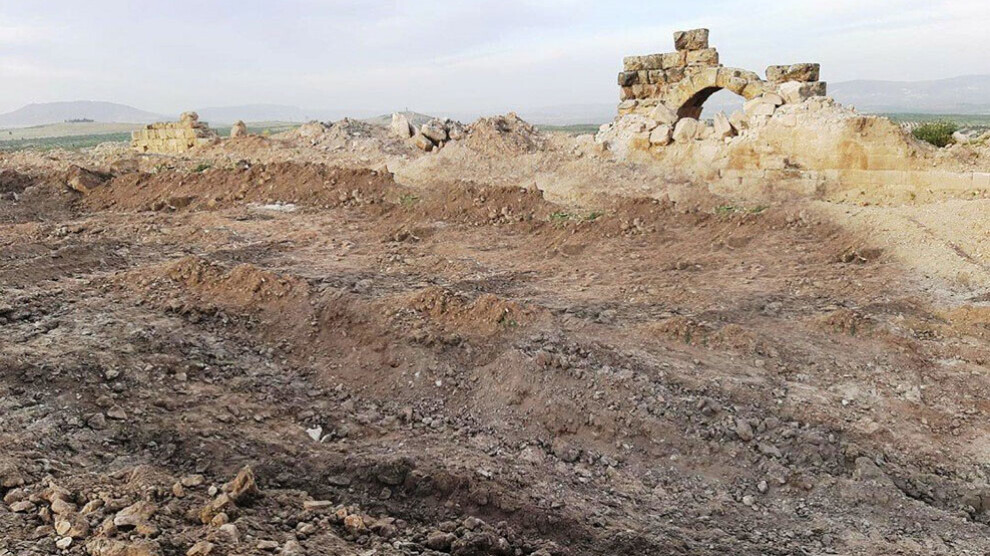Historical sites in Afrin looted and vandalized
In occupied Afrin, excavations were carried out by the occupation forces at more than 60 archaeological sites and the sites were devastated with construction machinery.
In occupied Afrin, excavations were carried out by the occupation forces at more than 60 archaeological sites and the sites were devastated with construction machinery.

According to recent reports by the Afrin Historical Sites Directorate, more than 60 historical sites have been looted in the Kurdish region in northwestern Syria occupied by Turkey and its mercenary forces. In 2021 alone, excavations were carried out with construction machinery on 15 settlement mounds. Already during the invasion, the Ishtar Temple of Ain Dara had been destroyed by a Turkish air strike. Among the destroyed and looted sites are UNESCO-recognized world cultural heritage sites.
"The Turkish state is trying to destroy history"
The co-chairman of the exiled Directorate for Historical Sites in Afrin, Selah Sîno, sees the destruction and looting as a historical-political strategy: "The Turkish state is trying to destroy history. It wants to impose its own understanding of history on the region and distort realities. The Turkish state is concerned with Ottoman history, which it wants to impose on Afrin. It is violating the 1954 Hague Agreement in the process. International law is being violated, but no one is saying anything."
Nebi Huri devastated with excavators
Sîno brings up a few examples of the destruction in an interview with the northern Syrian news agency ANHA: "Excavations with diggers and construction machinery took place in the Nabi Huri area. The Roman cemetery 650 meters away from Nabi Huri was excavated and looted. In 2019, a mosaic from Nabi Huri was torn out and taken out of the country through smuggling routes. The Directorate of Historical Sites of Afrin has documented this crime."
The mausoleum of Nabi Huri ("Prophet Huri"), revered as a wish-fulfilling Sufi by both Muslims and Christians, is located outside the city walls of the Hellenistic site of Cyrrhus, located in present-day Shera district near Afrin in the area of Çiyayê Kurmênc (Jabal al-Akrad, Eng. Mountain of the Kurds). The city, also known as “Hagioupolis” or “Khoros” dates back to 280 B.C. (Hellenistic era).
In Byzantine times, Cyrrhus was the capital of the province of Cyrrhestica in the Diocese of the East. Under Bishop Theodoret, the city became a popular destination for pilgrimages. The tower building called Mazar an-Nabi Huri from the 2nd or 3rd century was still considered an important pilgrimage destination until before the Turkish invasion of Afrin. Adjacent to the west is the former Roman cemetery, which was used as an Islamic burial site with some elaborately designed tombstones. In Islamic times, the mausoleum was given a new origin legend and received a mosque as an annex. The name Nebi Huri was transferred to the whole ruined area by the locals in the course of time.
The entire structure, including the pavement, was still intact until the start of the Turkish war of aggression against Afrin. At the end of January 2018, the site of Cyrrhus, the mausoleum of Nebi Huri, and the Hittite temple of Ain Dara suffered severe damage as a result of air strikes by the Turkish army. Since the occupation of the region, looting and destruction of the world cultural heritage there has been taking place on a large scale. The jihadist militias commanded by Turkey have now stolen all the items, including precious mosaics from Cyrrhus as well as Ain Dara. Satellite imagery suggests that both sites were bulldozed in 2019 and 2020.
Ain Dara destroyed and looted
Regarding the destruction of the 3,300-year-old Ishtar Temple of Ain Dara, Sîno says, "There are many photographs of it. The Turkish state and its mercenary troops have turned Ain Dara into a military training center. No one knows where the statues from Ain Dara were taken. A military base was built on one of the highest peaks of Jindires, Afrin."
RELATED NEWS: